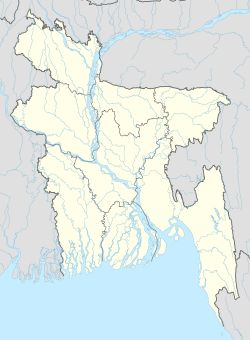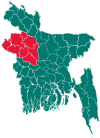world.wikisort.org - Bangladesh
Atrai (Bengali: আত্রাই) is the southernmost upazila of Naogaon District, located in Bangladesh's Rajshahi Division. It is named after its principal watercourse, the Atrai River.[1]
Atrai
আত্রাই | |
|---|---|
Upazila | |
 Atrai Location in Bangladesh | |
| Coordinates: 24°36.8′N 88°58.2′E | |
| Country | |
| Division | Rajshahi Division |
| District | Naogaon District |
| Government | |
| • Upazila Chairman | Ibadur Rahman Pramanik |
| • MP (Naogaon-6) | Anwar Hossain Helal |
| Area | |
| • Total | 284.41 km2 (109.81 sq mi) |
| Population (2011) | |
| • Total | 193,256 |
| • Density | 680/km2 (1,800/sq mi) |
| Time zone | UTC+6 (BST) |
| Website | Official website (in Bengali) |
Geography

Atrai has 30570 households and total area 284.41 km2. Along with the Atrai River, the Nagor River, Pakar Beel, Chander Beel, Kaklaban Beel are notable water bodies.
History

It is said that Islam Khan I, a Mughal Subahdar of Bengal, passed through Atrai (hence many villages have names such as Islampur and Islamganthi) and constructed a mosque known as the Islamganthi Mosque in the seventeenth century. Atrai later came under the zamindari of the Mollah political family.[2]
In 1916, Atrai was officially established as a thana. In 1968, the Mollah Azad Memorial College was founded in Atrai. During the Bangladesh Liberation War of 1971, a brawl emerged between the two factions in Bandaikhara on 19 September. Another encounter took place near Ghaulya and Taranagar. In a surprise attack, nine Pakistan Army ships were sunk. Its status was upgraded to upazila (sub-district) in August 1983 as part of the President of Bangladesh Hussain Muhammad Ershad's decentralisation programme.[1]
Demographics

According to 2011 Bangladesh census, Atrai had a population of 193,256. Males constituted 49.74% of the population and females 50.26%. Muslims formed 90.66% of the population, Hindus 9.31% and others 0.03%. Atrai had a literacy rate of 45.38% for the population 7 years and above.[3]
As of the 1991 Bangladesh census, Atrai has a population of 166978. Males constitute 50.88% of the population, and females 49.12%. The population above the age of eighteen years is 83466.
Administration

Atrai Upazila is divided into eight union parishads: Ashanganj, Bhonpara, Bisha, Hatkalupara, Kalikapur, Maniari, Panchupur, and Sahagola. The union parishads are subdivided into 155 mauzas and 200 villages.[4]
Chairmen
| Name | Notes |
|---|---|
| Bithindra Nath Saha | |
| Ohidur Rahman | |
| Muhammad Ibadur Rahman Pramanik | Present |
Facilities

Atrai Upazila has hundreds of mosques. Many of the mosques are notable tourist attractions in Atrai due to their antiquity or architectural style. These include the Islamganthi Mosque, Mahadighi Mosque, Qazipara Mosque and Mirpur Mosque.[1] The mazar (mausoleum) of Naib Ali the Dervish is situated in Sannyasbari.[5]
The upazila is home to other facilities such as the Madinatul Uloom Madrasa and Lillah Boarding Orphanage in Biharipur and the Bandaikhara Madhyapara Islamia Hafizia Madrasa and Orphanage Lillah Boarding.
Notable people
- Ohidur Rahman, politician
- Rabindranath Tagore, Nobel laureate who had lived here
See also
- Upazilas of Bangladesh
- Districts of Bangladesh
- Divisions of Bangladesh
References
- Muhammad Muklesur Rahman (2012). "Atrai Upazila". In Islam, Sirajul; Miah, Sajahan; Khanam, Mahfuza; Ahmed, Sabbir (eds.). Banglapedia: the National Encyclopedia of Bangladesh (Online ed.). Dhaka, Bangladesh: Banglapedia Trust, Asiatic Society of Bangladesh. ISBN 984-32-0576-6. OCLC 52727562. Retrieved 4 August 2022.
- Taru, Mazharul Islam (2012). "Molla, Ahsan Ullah". In Islam, Sirajul; Miah, Sajahan; Khanam, Mahfuza; Ahmed, Sabbir (eds.). Banglapedia: the National Encyclopedia of Bangladesh (Online ed.). Dhaka, Bangladesh: Banglapedia Trust, Asiatic Society of Bangladesh. ISBN 984-32-0576-6. OCLC 52727562. Retrieved 4 August 2022.
- "Bangladesh Population and Housing Census 2011: Zila Report – Nagaon" (PDF). Table P01 : Household and Population by Sex and Residence, Table P05 : Population by Religion, Age group and Residence, Table P09 : Literacy of Population 7 Years & Above by Religion, Sex and Residence. Bangladesh Bureau of Statistics (BBS), Ministry of Planning, Government of the People’s Republic of Bangladesh. Retrieved 9 December 2018.
- "District Statistics 2011: Naogaon" (PDF). Bangladesh Bureau of Statistics. Archived from the original (PDF) on 13 November 2014. Retrieved 14 July 2014.
- "মাজার". Atrai Upajela (in Bengali).
На других языках
- [en] Atrai Upazila
[ru] Атрай (подокруг)
Атрай (бенг. আত্রাই, англ. Atrai) — подокруг на северо-западе Бангладеш. Входит в состав округа Наогаон. Образован в 1916 году. Административный центр — город Атрай. Площадь подокруга — 284,41 км². По данным переписи 1991 года численность населения подокруга составляла 166 978 человек. Плотность населения равнялась 587 чел. на 1 км². Уровень грамотности населения составлял 000 %. Религиозный состав: мусульмане — 87,67 %, индуисты — 12,09 %, христиане — 0,03 %, прочие — 0,21 %.Другой контент может иметь иную лицензию. Перед использованием материалов сайта WikiSort.org внимательно изучите правила лицензирования конкретных элементов наполнения сайта.
WikiSort.org - проект по пересортировке и дополнению контента Википедии
